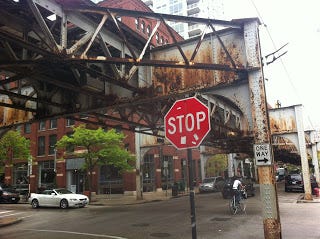The Crumbling City

Everywhere you go in Chicago you\'ll find signs of urban decay. Not the sort of middling decay you find in most cities but decades-old, ground in, well-worn and surprising decline. But crumbling walls, fragile sewers, rusting struts and wobbly bridges are not the sort of fabric upon which a thrusting and growing 21st century city is built upon.
So the task at hand for the new Mayor, Rahm Emanuel, is catch up with the long-overdue repairs to his city, while making the necessary improvements that will make sure that people want to move into the city rather than out of it. The city has little or no money, and citizens are against the idea of raising taxes. The state is broke too. Dribs and drabs come from the federal government. So how does one fund a serious $7 billion improvement program?
Besides borrowing more money, the answer in Chicago is to do something rather like a private finance initiative. This is to ask the private sector to come in and invest in projects that deliver some steady returns over a number of years.
Chicagoans have been rather anxious about this new idea. Rather ironically private finance of public projects is actually more common in \"socialist\" Europe. But in Chicago particularly, everyone remembers the parking deal that went bad. The time when a previous mayor sold the lease to the city\'s parking meters for 75 years for a fraction of its value. This is not the same idea. Nobody is talking about selling off the city\'s assets. The Chicago Infrastructure Trust wants to match private finance with investments in the city that will yield ongoing returns.
That is not to say that the idea is without risk, there are many things that can go wrong with private financing deals. The public side can end up taking on more risk than it realises when it has to pick up the pieces (a half finished school for example) when things go bad. (See Wikipedia on Criticism of PFI.) And if the investment depends on user fees (say a toll road), sometimes these can be uncomfortably high. And the costs of the project can be too high as well, as experience with school and hospital building has shown in Britain.
But if it is done properly, it absolutely does work--as experience with Britain\'s new Treasury building shows. And let us not forget how badly public-financed projects can go wrong. The new Scottish parliament building was originally supposed to cost 40m GPB ($64m), but actually cost 400m GPB.
So there are risks, and there are huge potential rewards. While there is anxiety, few appreciate the fact that Chicago needs to act quickly. It lost 200,000 people in the last decade. If this sort of pattern picks up in the next census, rather than reverses, it will be a disaster. Chicago could become just another one of those hollowed out former industrial Midwestern cities, with the wealthy taking refuge in the suburbs and the city loosing its energy and dynamism. Chicago has to be the place that people seek out in the Midwest, not flee from.
So when the mayor says that the city cannot afford to wait for the federal government to act with regards to infrastructure investments, he probably means it. By the time the next census comes around in a decade from now, the city needs to have stemmed or reversed this trend of population decline. Its a tough nut to crack, but this probably explains why the new major has been like a hyperactive squirrel in the last year, scurrying from new project to new project. Time is of the essence.



